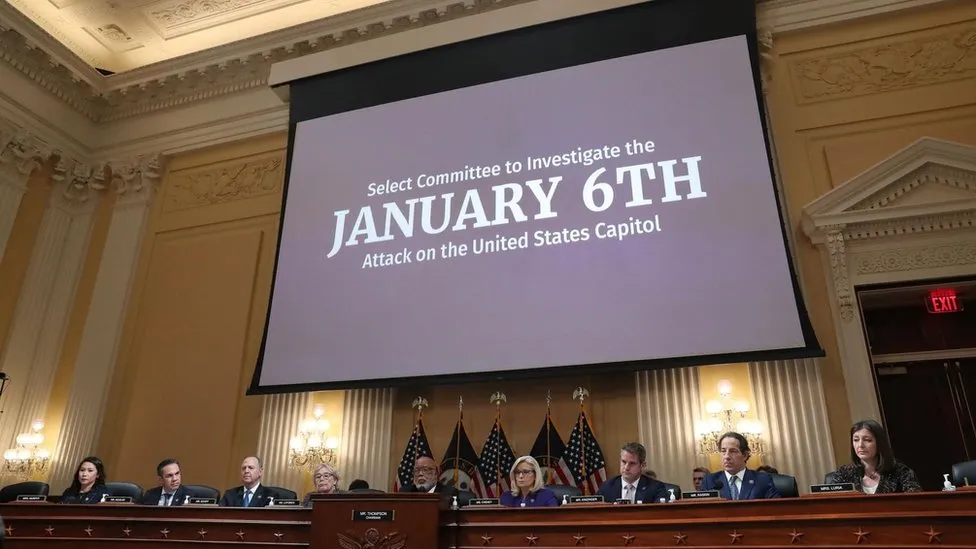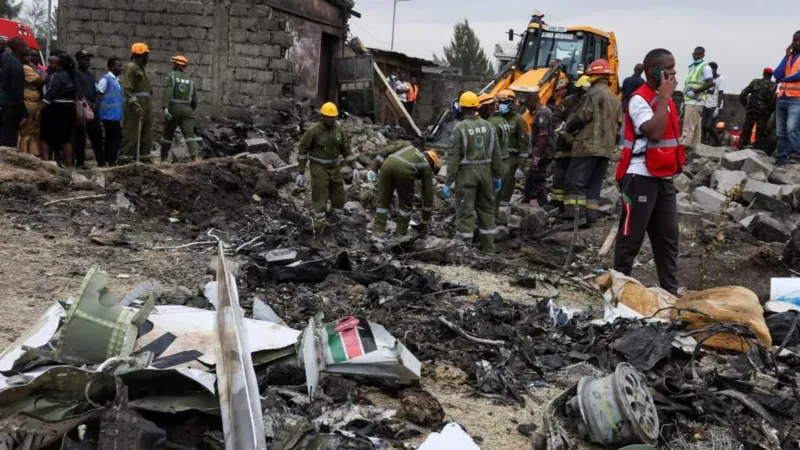Donald Trump accused of multi-part conspiracy over 6 January attack
The congressional panel investigating last year's attack on the US Capitol has accused former President Donald Trump of a "multi-part conspiracy" to overturn his election defeat three months earlier.

The panel has released its final 845-page report on the attack.
It places the blame for the 6 January 2021 storming of Congress squarely on the former president.
It also recommends barring Mr Trump from public office in the future.
He did not co-operate with the panel and declared the final report a "witch hunt" after its release.
Over 18 months, the committee held 10 public hearings and interviewed more than 1,000 witnesses, including Trump administration officials and staff, Trump family members, Capitol police officers, rioters, militia members, and more.
On Monday, the panel of seven Democrats and two Republicans recommended the justice department investigate Mr Trump - who is mounting another White House campaign - for aiding an insurrection and three other federal crimes.
The Democratic chairman of the select committee, Bennie Thompson of Mississippi, wrote in a foreword to the eight-chapter report that it was once "unimaginable" that the president of the United States would incite a mob to march on the Capitol.
Here are the six key findings, which were released on Thursday night:
Far-right groups had racism rift before Capitol riot
The committee said that Mr Trump's decision to falsely declare victory on election night 2020 was "premeditated", and that only his lawyer, Rudy Giuliani, supported this action. The former president soon began making unfounded claims of widescale voter fraud, and continued to do so with more frequency after the election was called for Joe Biden.
The committee points to their interviews with several advisers and lawyers close to Mr Trump, who say they did not believe these claims of fraud or could find no evidence of the phenomenon.
Most notable among those voices was former Attorney General William Barr, who told the committee during a deposition: "I made it clear that I did not agree with the idea of saying the election was stolen and putting out this stuff, which I told the president was [expletive.]"
The president continued to sow election conspiracies over the coming weeks, though top Trump administration officials testified they informed him the claims were not true.
The committee makes the argument that the attack on the Capitol was sparked by Mr Trump himself.
In addition to Mr Trump's repeated fraud claims, the committee points to a 19 December 2020 tweet, in which the former president wrote: "Big protest in DC on January 6th. Be there, will be wild!"
In depositions and court documents, rioters and militia members who were present at the Capitol that day cited Mr Trump's tweet as their rationale for coming to Washington. The committee cited men like Robert Morss, who was found guilty of assaulting officers during the Capitol breach. Mr Morss "believed January 6th stood for the moment when '1776 Will Commence Again' because President Trump asked them to 'Be there, Will be Wild'", the report states.
The committee also cites Secret Service warnings that people were planning to come to Washington on January 6 and threatening to "be wild".
Some of their conclusion rests on the testimony of former White House staffer Cassidy Hutchinson, who appeared in a dramatic hearing earlier this year and also gave depositions about the chaos she says she witnessed in the White House that day.
According to a transcript of her testimony released on Thursday, a former White House ethics lawyer had attempted to coach Ms Hutchinson before she gave evidence to the committee: "The less you remember, the better."
The committee also cites communications between lawmakers trapped in the Capitol and White House chief of staff Mark Meadows, who was receiving an increasingly desperate barrage of pleas from members of Congress who were forced into hiding.
Texts from Hope Hicks, one of Mr Trump's most loyal aides, summed up the dismay among staff at the White House.
Ms Hicks texted Ivanka Trump's chief of staff, Julie Radford, after the riot saying "we all look like domestic terrorists now".
She also texted a White House lawyer: "I'm so upset. Everything we worked for wiped away."
Tips about armed groups targeting Washington and even the Capitol specifically started coming in December 2020. The report notes that the FBI was sent messages circulating on groups run by the far-right Oath Keepers and Proud Boys.
"There is only one way. It is not signs. It's not rallies. It's [expletive] bullets," said one.
Capitol Police and Secret Service agents - who are responsible for protecting the president - received similar messages from insiders and others. Some specifically named the Capitol as a focus for potentially violent activity.
Some of the chatter came from private encrypted chat apps, but other messages were publicly visible on pro-Trump websites and Twitter.
Members of the far-right groups ended up among the crowds inside the Capitol on 6 January.
-bbc






